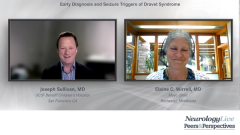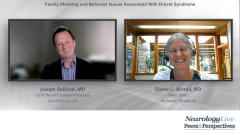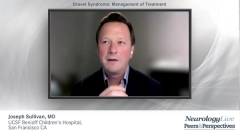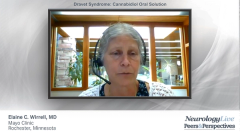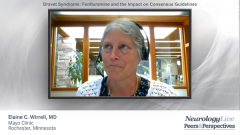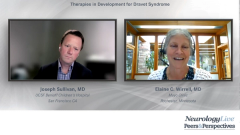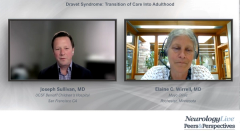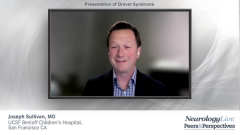
Dravet Syndrome: Transition of Care Into Adulthood
Joseph Sullivan, MD, and Elaine C. Wirrell, discuss the transition of care into adulthood of patients with Dravet syndrome.
Episodes in this series

Joseph Sullivan, MD: I see some of my patients with Dravet syndrome up to the age of 22, 23. But we know that there are many adults living with Dravet syndrome, and they are frustrated that many of these clinical trials they’re not eligible for. But I wonder if we could take a minute to speak to issues that are important when our young adults transition to adult epilepsy providers, and how we can help them and help our colleagues through that transition.
Elaine C. Wirrell, MD: It’s a tough time, as you know, for families. They’re suddenly having to move on to a new medical team. They’ve been with us often for 15, 20 years, and so they know us well. It’s often a time of anxiety for them, but I do think it’s really important because many of our children’s hospitals have an upper age limit beyond which you cannot admit [a patient], and if you’re in a medical crisis and suddenly that’s when you’re meeting your adult team, that’s not a good time. And then, many of those young adults will actually develop other adult medical conditions that we as child neurologists are not very comfortable dealing with. I do think the need to transition is really important. It’s a process, so it’s something that I sit down and talk with families about and make sure they understand how Dravet syndrome evolves, how seizures evolve. As you go from childhood through to young adulthood, seizures are often briefer. You often don’t see the myoclonics or the absences anymore, but some of the other comorbidities can worsen. Sometimes behavior problems, anxiety issues, gait problems, or even Parkinsonian features can emerge, so [they need to] know what to watch for there.
I think the legal and financial side is also really important to have a discussion about, and that’s typically our social workers who will get involved with the families. Have a discussion about ensuring guardianship is in place by the time that the person turns 18, so that parents can continue to be the decision makers for their child. We need to make sure that if insurance is going to change, if you are on state Medicaid and suddenly when you turn 19 that’s going to change, they understand that, and they continue to get good medical insurance. Then what we can do for our adult colleagues is to provide them a much more succinct document of summarizing that particular patient. For many of these patients, if you look at paper charts, they used to be stacked up to here, and there would be several stacks. And I think the EMR [electronic medical record] has not made things easier; there’s often more papers involved. I think from our standpoint, we know this patient well; a quick 2-to-3-page summary that we can provide to our adult colleague to say, “Here are the medications the patient is on. Here are the ones they’ve tried in the past.” We don’t want to repeat a medication if it didn’t work, or if it caused an [adverse] effect. Dietary therapies, what investigations have been done, what comorbidities does this person have. Within 2 to 3 pages, they get a really nice summary of who that patient is.
I think [we can] also just be there for any questions your adult colleague has. Where I work, I’m fortunate that I can sometimes go to the first visit with the adult neurologist, and that’s super helpful, but I know that in many cases that’s not possible because those visits take place in different centers. Whatever we can do to ensure that our adult colleagues are able to know that patient well, and that we’re there if there are any questions about therapies they may want to use [is important].
Joseph Sullivan, MD: Absolutely. I couldn’t agree more about this individualized document that can capture things that aren’t necessarily apparent in the medical record, a lot of the psychosocial background, and the journey we’ve been on with these families. We know, because as you said, they’ve been with us for 15 years, and those are still important features to the care of a patient and the family. I know you and I and others are trying to come up with a document as well that gives guidelines and tips for the adult neurologist and epileptologist to understand what issues are important to the young adult with Dravet syndrome and also to understand where they’ve come from. We should be mindful of someone who had their first seizure 20 years ago, and likely was not treated in an optimal way just because we didn’t have great options; multiple episodes of status [epilepticus]. There’s certainly a lot of trauma that needs to be processed by the family and is good for the adult providers to know.
The fact that we’re having this conversation and that people are hopefully watching, I think is amazing, to see how far we’ve come. It’s a testament to organizations like the Dravet Syndrome Foundation, interest from industry, and trying to help these rarer pediatric epilepsies. It’s been certainly a journey for my career here.
Elaine C. Wirrell, MD: I think it’s been super exciting to see all of these advances and what’s on the horizon, the potential to even cure this with genetic therapies, so that’s super exciting. I think though, we’re not quite there yet, and we still have patients who are having lots of seizures. I think also looking beyond the seizures, the comorbidities can also be super impactful on quality of life for those patients as well as their families and siblings. We don’t want to lose sight of that, and its support for the family.
Joseph Sullivan, MD: Well, thank you. As always, it’s great chatting with you. Hopefully, we’ll be together in person soon.
Elaine C. Wirrell, MD: Thank you.
Joseph Sullivan, MD: Thank you for watching this NeurologyLive® Peers & Perspectives®. If you enjoyed the content, please subscribe to our e-newsletters to receive upcoming programs and other great content in your inbox. Thank you so much.
Transcript Edited for Clarity
Newsletter
Keep your finger on the pulse of neurology—subscribe to NeurologyLive for expert interviews, new data, and breakthrough treatment updates.

